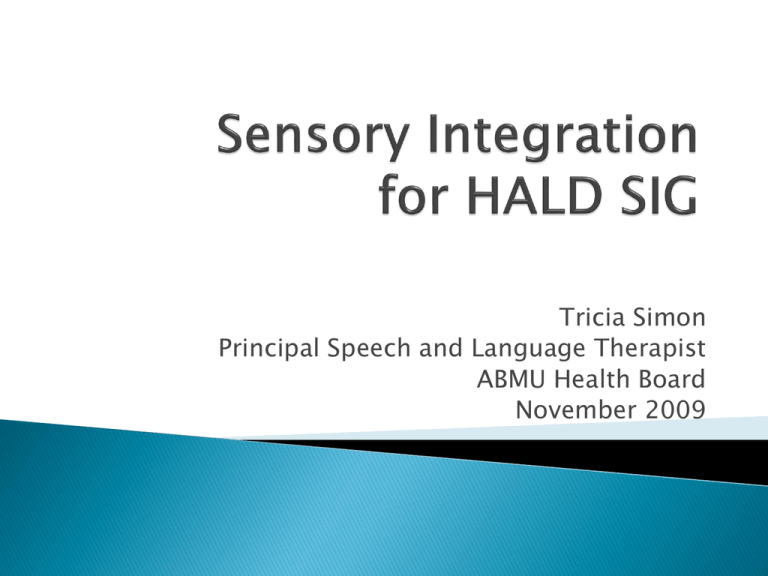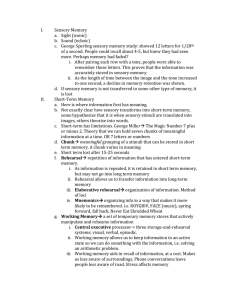A sensory attachment approach to learning
advertisement

Tricia Simon Principal Speech and Language Therapist ABMU Health Board November 2009 What is sensory integration Which client groups often have difficulty with this skill Which professionals may be involved What might intervention look like – case examples Sensory integration is the neurological process that organises sensation from one’s own body and from the environment and makes it possible to use the body effectively within the environment. Sensory integration is information processing. The brain must select, enhance, inhibit, compare and associate the sensory information in a flexible, constantly changing pattern, in other words the brain must integrate it. Physical clumsiness Difficulty learning new movements Activity level unusually high or low Poor body awareness Inappropriate response to touch, movements, sights or sounds Poor self esteem Social and/or emotional difficulties Pervasive Developmental Disorder (including Autism and Aspergers Syndrome) Attention Deficit Hyperactivity Disorder (A.D.H.D./A.D.D,) Learning Disorders ( i.e. specific learning difficulties e.g. dyslexia) Developmental Disabilities Fragile X Syndrome Developmental Coordination Disorder [DCD] (including Dyspraxia) Often Occupational Therapists Speech and Language Therapist Physiotherapist The focus or goal of intervention may change depending on the professional background. Profiles and direct assessment of visual auditory tactile olfactory gustatory vestibular - movement proprioception – body position Levels of self regulation 1. Autonomic regulation Biological regulation e.g. sleep, digestion, temperature. 2. Modulation Regulation of arousal levels in response to stimuli 3. Sensory discrimination Interpret and organise information 4. Executive function Modulate, interpret and organise response Seek out excessive amounts of one type of stimulation Avoid specific sensations May be agitated, constantly on the go Or quiet, withdrawn, self abusive, sleep a lot May fail to register or recognise stimulus and ignore what is happening May respond with alarm as they don’t fully understand what is happening Sensory difficulties may result in client operating only in survival mode Mental state cognition Area of brain calm abstract Neocortex aroused Concrete, rigid Subcortex alarmed Emotional Limbic fear reactive Midbrain terror Reflex only brainstem Survival response may be: Freeze, defiance, aggression Or avoidance, compliance, dissociation Hyper excited or defensive Shut out stimuli through to shut down Response to stress: freeze, fight, flight, fright, vigilance? How do they self calm? E.g. head bang, deep pressure Calm, alert and attentive Hypo: Under responsive or high threshold How do they alert themselves e.g. spinning, chew Assessment leads to a profile of the amount, type and duration of sensory stimulus the person can cope with Aim to facilitate a controlled regulated response to all sensory stimuli through the just right combination of alerting and calming stimuli ALD – work at first two levels of regulation and modulation to achieve a calm alert state to allow learning and relating to others. Control volume of stimuli in the environment Education for carers e.g. tactile defensive, not rejecting touch/affection. Aim to sensitise parents and carers to the individual’s behaviours and help them become aware of and modify their interactional styles according to the individual’s cues. Therapist support carers to carry out intervention (rather than carry out the intervention themselves) Taste/smell Calming/nurturing Alerting/Challenging Sweet, vanilla, salt Sour, citrus, spice, bitter Oral texture Suck, blow, bite, crunch Chew, lick temp Cool to moderate extreme tactile deep pressure Light/unexpected touch movement Stretch and resistance (hang, pull, push, crawl, carry heavy load), bounce Linear move e.g. swing Rotary move e.g. spin auditory Vibration, rhythm music Speech sounds Observe what the individual seeks. Aim for the individual to remain regulated during all stimuli. Initially therapist/carer acts as regulator by structuring environment. Eadaoin Bhreathnach: OT and counsellor Uses theories of Sensory integration Attachment classification Use of therapeutic space from both sensory processing and attachment perspectives. Observed behaviour may be due to sensory or emotional difficulties. Different types of insecure attachment have different sensory profiles e.g. Avoidant child likely to be tactile defensive, may use freeze/compulsive compliance anxious child likely to be aggressive during fast movement and unstable surfaces. Sensory difficulties may result in attachment difficulties in LD e.g. tactile defensiveness. Question: Why is the client doing a behaviour Potential answers Can’t tolerate the sensation – hyperexited or defensive reaction Not enough sensory information (high threshold or under responsive) – sensory seeking Cognition/ stage of development; difficulties with perception and misinterpretation. Past ‘trauma’ or negative experience Communication Emotional/attachment e.g attract attention Start where is comfortable in terms of physical space and sensory stimulation – don’t trigger a self stimulatory/ SIB reaction or survival mode Tune in Work at their pace Stop before triggering threshold for stimuli – ensure a positive experience Parallels with Intensive Interaction approach Withdraws (‘sleeps’) at day service – in foetal position in wheelchair with t-shirt over his head Moves away when touched Emerges to accept food and drink only Foster carers – chews bedding/mattress at home Levels of self regulation; John 1. Autonomic regulation - physiological Rubella stress pattern Chest infection ?gastric issues 2. Modulation Avoidant Hypervigilant? Disengages tone Self soothes – taps his head Tactile defensitve posture 3. Sensory discrimination - interpret Postural control very good Follows instructions around food, active withdrawal at other times 4. Executive function Organise around food and posture Hyper excited or defensive Shut out stimuli through to shut down Response to stress: freeze, fight, flight, fright, vigilance? How do they self calm? E.g. head bang, deep pressure Calm, alert and attentive Hypo: Under responsive or high threshold How do they alert themselves e.g. spinning, chew Cut out/shut down – foetal position, under bedclothes/t-shirt, eyes closed Stress reactions Freeze – foetal position Fight – SIB banging head, destroying mattress Flight – move away Fright – scream Tactile defensiveness – Is he defensive to the sensation or emotional avoidance/control? Tapping head Tshirt pressure Foetal position – pressure on joints Chew Suck Retreats into self Aim to engage in positive experience – tune in and mirror what he seeks Aim for calm alert state so need to use calming interventions Sucking Bite –melt foods Chewing Movement (car, rocker) Deep pressure – careful in case control issues Rhythm of SIB or tapping Autistic Hyperexcited signs – smile, bounce up and down, hands in mouth can then escalate to agitation (pacing, rocking), aggression, and not registering pain. Triggered by pub, football match – important for relationship with Dad. Levels of self regulation; Paul 1. Autonomic regulation – lots of physiological issues Low tone, epilepsy, cleft palate, hayfever, eczema, allergies, tunnel vision, middle ear problems, high sugar intake, high urine output 2. Modulation Low tone – difficulty regulating muscle control Seeking proprioception (jumping) Tactile defensive – either emotional or postural challenge not sensory 3. Sensory discrimination - interpret Auditory processing problems, body scheme problems Delayed processing with food, cognition Gravitational insecure (won’t tilt head) 4. Executive function Problems planning movement – uses reflex fight/flight Regulate during family activities by Reducing noise (ear coverings?), therapeutic listening to reduce defensiveness. Provide calming stimuli –lots of proprioception (pull, push, lift, hold) e.g. chewing dried fruit/ carrot/ apple, suck on water bottle, trampoline, squeeze ball, walk hills Primary need is to address health and physiological difficulties e.g. tunnel vision Lots of input for challenging/self injurious behaviour but no solutions found to date Often sleeps at day service (staff report this as a good day) Noisy at home Difficult to engage and interact with Signs of hyperexcitation Fight – hits self Flight – increased agitation Fear – when carer moves away increased SIB What calms – hitting self on head, hitting foot on wheelchair Calm alert state 1:1 on holiday Nurturing type activities (massage, cuddles, food) Being outside Water hoist Sleep – is this shut down/escape from sensory overload at day service? Tactile defensiveness – trigger for SIB Vestibular – postural insecurity and needs lots of proprioception (deep pressure) but without being worried about balance Auditory – can’t cope with sudden sounds Fear reaction when staff move away – attachment Give staff strategies to support calm state and evidence the need for 1:1 What is the person’s past experience and learning? What patterns is the person following – emotion or sensory based, or is there another reason for their actions e.g. communication, cognition/ developmental level. What will help e.g. environment, activities/sensations Sensory integration network UK and Ireland www.sensoryintegration.org.uk






